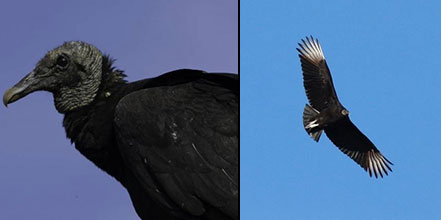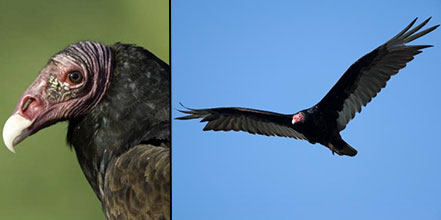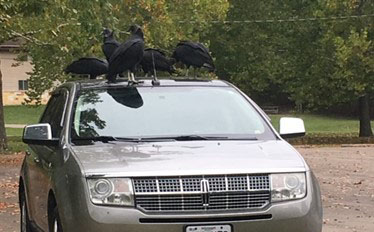Black vultures (Coragyps atratus) are a native species to Missouri. In the 1990s, black vulture populations began expanding into other regions of the US, including larger populations being observed in the state. Though they are a migratory species, they can be found in Missouri throughout the year; as southern populations migrate further south and northern populations from northern US states and Canada migrating into the area to replace or mingle with resident birds, leading to local increases during the fall and winter. Over the past few years, their population numbers have increased to the point where they are common across much of the state.
Black vultures are a medium-sized vulture at 23 to 27 inches in height with a wing spread upwards of 5 feet, and they weigh around 3.5 to 5 lbs. They are slightly smaller than the turkey vulture (Cathartes aura), the other native vulture in Missouri, and can be distinguished from them in several ways.





- Black vultures have a gray-black head. In flight they hold their wings in a more horizontal position and tend to flap more often than turkey vultures (Figure 1).
- As an adult, turkey vultures have a bright red head. However, juvenile turkey vultures also have gray heads, so younger birds can be confused with black vultures. Turkey vultures have a more V-shaped profile and soar for longer durations without flapping (Figure 2). Turkey vultures will rock from side to side and make sudden dips without flapping their wings, almost as if walking a tightrope, unlike the black vulture.
- From below, a black vulture appears to have a pale "hand" where the outer flight feathers are white and contrast with the black body and wing (Figure 3a). This is distinct from the turkey vulture, which has uniformly pale flight feathers across the wing (Figure 3b).
Vultures play a critical role in the environment as scavengers of carrion. They provide an important ecological service in consuming carcasses of deceased animals which reduces the risk of diseases from spreading in the environment. Turkey and black vultures, as with all other wildlife, will take advantage of resources available to them; unfortunately, this can cause issues when it involves human dwellings and, in some cases, livestock operations.
Black vultures are increasing in population, and their aggressive nature can cause problems for livestock producers in Missouri. Unlike their shy and non-aggressive turkey vulture cousins, black vultures are known to gang up and prey upon calves, piglets, lambs, and newborn goats. They sometimes attack cows that are ill or giving birth. Black vultures can also cause property damage and problems by damaging rubber seals and windshield wipers on parked vehicles, canvas awnings and seating on boats, and rubber or vinyl materials on rooftops (Figure 4).
It is illegal to harm or take (kill) black vultures without a permit. Black vultures are protected under the federal Migratory Bird Treaty Act of 1918. Their migratory range extends for thousands of miles from North America to the lower portions of South America, crossing national boundaries.
As discussed, vultures provide a vital ecosystem service as scavengers by cleaning the environment of carrion. Carcasses not scavenged by vultures decompose slower and attract mammalian carnivores such as coyotes. As the number of animals being killed by vehicle collisions has generally increased, the potential food source for vultures and mammalian carnivores has also increased. Vultures take advantage of these food sources just as other scavengers have as well. Thus, it is important to improve our understanding of these benefits and develop programs that help ensure the protection of livestock while protecting populations of vultures within the ecosystem.
More detailed information on black vulture feeding behavior, determining whether black vultures caused livestock death and depredation, techniques that can be used to prevent problems, and sources of assistance, can be found within the MU Extension Guide G9466, Controlling Nuisance Black Vultures in Missouri as well as within the Prevention and Control section of this page.